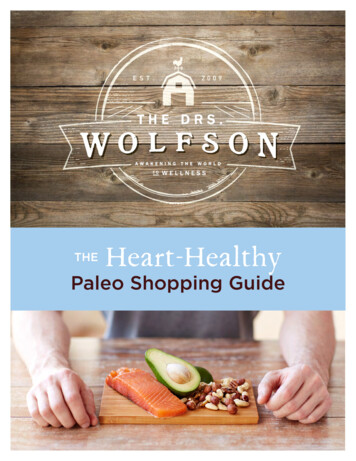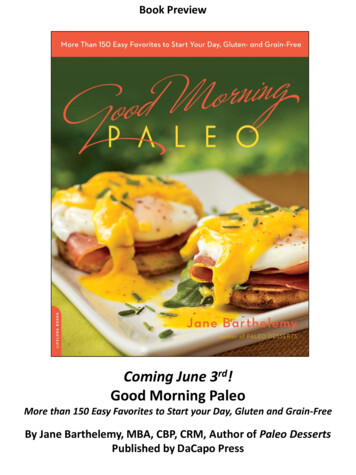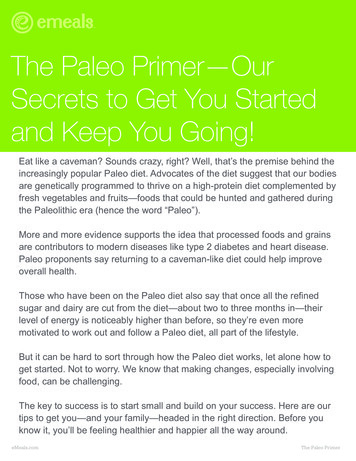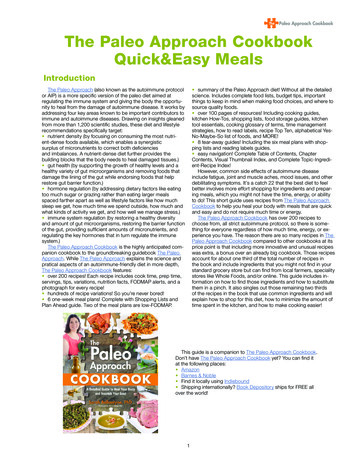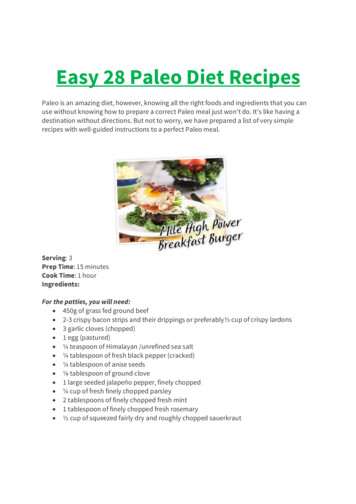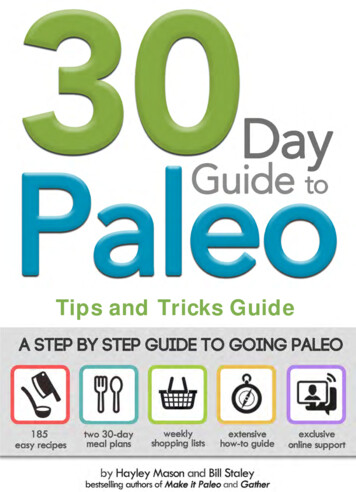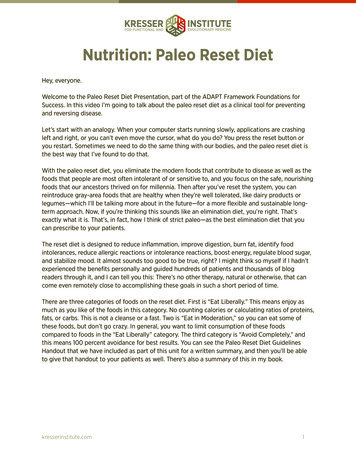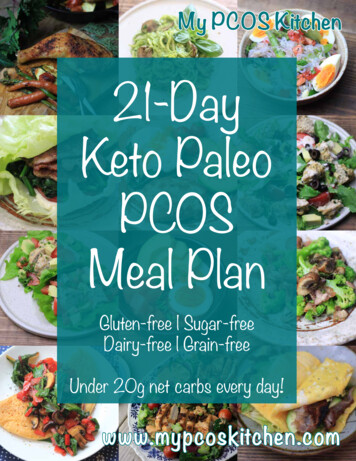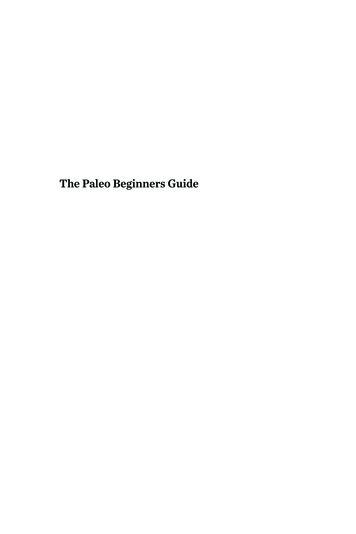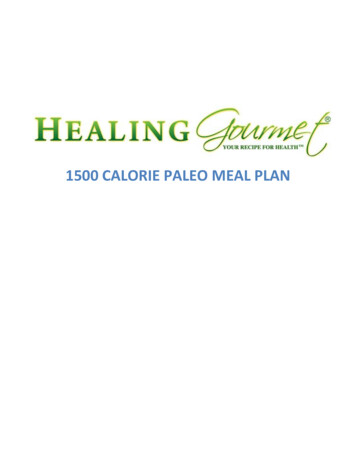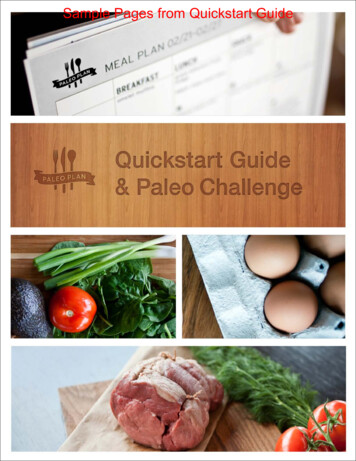
Transcription
Sample Pages from Quickstart Guidepaleoplan.com 1
Sample Pages from Quickstart GuideTable of ContentsCH 1. Introductions . . . . . . . . . . . . . . . . . . . . . . . . . . . . . . . 1Why Paleo? . . . . . . . . . . . . . . . . . . . . . . . . . . . . . . . . . . . . . . . . . . . . . . . 4Overview of the Challenge . . . . . . . . . . . . . . . . . . . . . . . . . . . . . . . . . . . 5CH 2. About the Diet . . . . . . . . . . . . . . . . . . . . . . . . . . . . . . 7Quiz: Should You Go Paleo? . . . . . . . . . . . . . . . . . . . . . . . . . . . . . . . . . 7A Little History . . . . . . . . . . . . . . . . . . . . . . . . . . . . . . . . . . . . . . . . . . . . 8A Little Science . . . . . . . . . . . . . . . . . . . . . . . . . . . . . . . . . . . . . . . . . . . . 9Grains . . . . . . . . . . . . . . . . . . . . . . . . . . . . . . . . . . . . . . . . . . . . . . . . . 9Gluten . . . . . . . . . . . . . . . . . . . . . . . . . . . . . . . . . . . . . . . . . . . . . . . . . 9Certain Lectins . . . . . . . . . . . . . . . . . . . . . . . . . . . . . . . . . . . . . . . . 10Phylic Acid . . . . . . . . . . . . . . . . . . . . . . . . . . . . . . . . . . . . . . . . . . . . 10Legumes . . . . . . . . . . . . . . . . . . . . . . . . . . . . . . . . . . . . . . . . . . . . . . 10Nuts and Seeds? . . . . . . . . . . . . . . . . . . . . . . . . . . . . . . . . . . . . . . . . 11Refined Sugars . . . . . . . . . . . . . . . . . . . . . . . . . . . . . . . . . . . . . . . . . 11Vegetable Oils . . . . . . . . . . . . . . . . . . . . . . . . . . . . . . . . . . . . . . . . . 12Pasteurized and Homogenized Dairy . . . . . . . . . . . . . . . . . . . . . . 13Unnecessary Additives . . . . . . . . . . . . . . . . . . . . . . . . . . . . . . . . . . 14Exercise, Sleep, Stress, and Cortisol . . . . . . . . . . . . . . . . . . . . . . . . . . 14Research to Support Paleo . . . . . . . . . . . . . . . . . . . . . . . . . . . . . . . . . . 15Real-Life Testimonials . . . . . . . . . . . . . . . . . . . . . . . . . . . . . . . . . . . . . 17CH 3. Food Guide . . . . . . . . . . . . . . . . . . . . . . . . . . . . . . . . 20Unrestricted Foods . . . . . . . . . . . . . . . . . . . . . . . . . . . . . . . . . . . . . . . . 20Consume in Moderation . . . . . . . . . . . . . . . . . . . . . . . . . . . . . . . . . . . . 22Foods to Avoid . . . . . . . . . . . . . . . . . . . . . . . . . . . . . . . . . . . . . . . . . . . . 23CH 4. FAQ . . . . . . . . . . . . . . . . . . . . . . . . . . . . . . . . . . . . . 26Diabetes and Paleo . . . . . . . . . . . . . . . . . . . . . . . . . . . . . . . . . . . . . . . .Nuts and Protein Powders . . . . . . . . . . . . . . . . . . . . . . . . . . . . . . . . . .Budgeting for the Diet . . . . . . . . . . . . . . . . . . . . . . . . . . . . . . . . . . . . .Breakfast and Intermittent Fasting . . . . . . . . . . . . . . . . . . . . . . . . . . .High-Protein Diet Myths . . . . . . . . . . . . . . . . . . . . . . . . . . . . . . . . . . .Nutrients . . . . . . . . . . . . . . . . . . . . . . . . . . . . . . . . . . . . . . . . . . . . . . . .Dairy . . . . . . . . . . . . . . . . . . . . . . . . . . . . . . . . . . . . . . . . . . . . . . . . . . .Saturated Fat Cholesterol Myths . . . . . . . . . . . . . . . . . . . . . . . . . . . . .Nut and Egg Allergies . . . . . . . . . . . . . . . . . . . . . . . . . . . . . . . . . . . . . .Troubleshooting Weight Loss and Cravings . . . . . . . . . . . . . . . . . . . .What to Drink . . . . . . . . . . . . . . . . . . . . . . . . . . . . . . . . . . . . . . . . . . . .Fatigue and Detoxification . . . . . . . . . . . . . . . . . . . . . . . . . . . . . . . . . .272829293031333437383940paleoplan.com i
Sample Pages from Quickstart GuideCH 5. Putting It Into Practice . . . . . . . . . . . . . . . . . . . . . . . 42Cleaning Out Your Kitchen . . . . . . . . . . . . . . . . . . . . . . . . . . . . . . . . . 42Changing It up for the Athlete . . . . . . . . . . . . . . . . . . . . . . . . . . . . . . . 44What to Eat at Restaurants . . . . . . . . . . . . . . . . . . . . . . . . . . . . . . . . . . 48CH 6. Guidelines of the Challenge . . . . . . . . . . . . . . . . . . . 49Diet Log . . . . . . . . . . . . . . . . . . . . . . . . . . . . . . . . . . . . . . . . . . . . . . . . .Point System . . . . . . . . . . . . . . . . . . . . . . . . . . . . . . . . . . . . . . . . . . . . .Before and After . . . . . . . . . . . . . . . . . . . . . . . . . . . . . . . . . . . . . . . . . .Bloodwork . . . . . . . . . . . . . . . . . . . . . . . . . . . . . . . . . . . . . . . . . . . . . . .Goals . . . . . . . . . . . . . . . . . . . . . . . . . . . . . . . . . . . . . . . . . . . . . . . . . . . .4949515252CH 7. Resources . . . . . . . . . . . . . . . . . . . . . . . . . . . . . . . . 53CH 8. Weekly Meal Plans, Shopping Lists, Staples List . . . 57Following the Meal Plan . . . . . . . . . . . . . . . . . . . . . . . . . . . . . . . . . . . . 57Weekly Meal Plans and Grocery Shopping Lists . . . . . . . . . . . . . . . . 60Recipes . . . . . . . . . . . . . . . . . . . . . . . . . . . . . . . . . . . . . . . . . . . . . . . . . . 73paleoplan.com ii
Sample Pages from Quickstart GuideWelcome to Paleo. Hopefully, you’vecome across this book because youINTRODUCTIONSwant help with eating better andliving more fully. If you’re new toPaleo, then you’ll find lots of fantastic information in this bookto explain the basics: why one food is considered Paleo, andothers—especially foods you’ve been taught were healthy—aren’t. You’ll also find an explicit plan for eating Paleo for thenext six weeks, with meal plans, shopping lists, and recipes.chapter 1Maybe your doctor suggested eating Paleo, or a friend has magically transformedhis body. If that’s the case, you’re well set. You may have been encouraged to do aPaleo “Challenge” by your gym, CrossFit box, or trainer. For you, we’ve got somerules of the game and tips on getting the most from this challenge. Hopefully,you’ll like how you perform and how you look enough to keep eating Paleo afterthe challenge.If you got this book without any knowledgeof a Paleo Challenge, don’t worry. Youencourage you to read thisdon’t have to do all the before and afterentire short book, you canmeasurements and pictures, or the foodalso just read the nextjournal. However, we do recommend it.couple pages to find outThere’s something about havingwhat the diet and challengeaccountability, whether it’s to yourself orare all about in a nutshell.a friend who’s doing it with you, that helpskeep you honest and on track. We highly recommend at least reading throughthe challenge portion in Chapter 4.While we wholeheartedlyWhile we wholeheartedly encourage you to read this entire short book, you canalso just read the next couple pages to find out what the diet and challenge areall about in a nutshell. Then when you have more time or your interest has beenpiqued, read the whole book to learn about the science and history behind eatinglike our Paleolithic ancestors. That way, you’ll be armed with sound argumentsto your friends’ preposterous assertions that eating Paleo will give you gout and aheart attack.paleoplan.com 3
Sample Pages from Quickstart GuideHere’s your food guide for the nextsix weeks—and hopefully for theFood Guiderest of your life. The green headingsmean “GO”: eat those foods allyou want. Yellow means use caution and eat those foods inmoderation, and red means—well, you get the picture.chapter 3ABOUT WEIGHT LOSSEating Paleo is not necessarily about weight loss. It’s a great way to eat if you’retrying to lose, maintain, or even gain weight. However, many people come to itfrom a position of trying to improve their body composition (how much muscletone and bulk they have.). Throughout this chapter, we’ll let you know when it’ssafe to eat something, but also when to be careful with moderation if weight lossis a goal of yours.UNRESTRICTED FOODSVegetablesYou can eat all vegetables without limit. You’ve probably never met anyonewho got fat eating too much broccoli! The only exception is that you shouldnot eat plants from the nightshade family if you have an autoimmune disorder.Nightshades are tomatoes, peppers, eggplant, potatoes, and tobacco. And fornow, if you’re trying to lose weight, lay off the root veggies below.If weight loss is a goal, limit these root vegetablesAtkins was right about a few things, the first being that carbs can cause weightgain. So because the foods below are high in carbohydrates, eat these starchycarbs no more than a few times a week. If you’re an athlete, read Chapter 5 forguidelines about carbohydrates. Here’s an easy-to-read blog post on the topicof athletes and carbs.Cassava (Tapioca)PotatoesYamsSweet potatoesTaroPlantainFruitsYou can eat as much fruit as you want. However, if you’re trying to loseweight, limit fruit intake to one to four pieces a day and limit dried fruit to asmall handful a day.paleoplan.com 20
Sample Pages from Quickstart GuideUNRESTRICTED FOODSSea VegetablesThey’re all good—great, in fact. They’re very high in minerals and irulinaFatsWatch your intake of all of these if you’re trying to lose weight—they’re verycalorie dense. A tablespoon of each is about 120 calories. Learn about how touse each of these in the Paleo Guide to Oils and Fats included with this ebook.TallowLardCoconut oil/milkWalnut oilFlax oilHazelnut oilExtra Virgin Olive oilMacadamia oilUnrefined Red Palm oilBeveragesFiltered or spring waterHerbal teaCONSUME IN MODERATIONCoffeeChocolateDried fruitAlcohol (all)Caffeinated teasRaw honeySteviaCoconut sapCoconut waterFreshly juiced fruits and vegetablesOther types of caffeinated drinks (it should be a treat—not a crutch)paleoplan.com 22
Sample Pages from Quickstart GuideFOODS TO AVOIDDairyAt least for the duration of this challenge, we suggest you avoid all dairyproducts. Read the section on dairy in Chapter 2 and the dairy discussion inChapter 4 for more information on dairy’s place in the Paleo diet.ButterButtermilkMilkYogurtKefirCreamGheeIce creamPowdered milkCottage cheeseAnything else from an animal’s teatGrains or Grain-Like FoodsRefer to this section in Chapter 2 for the reasons to avoid wheatWild riceAmaranthSorghumRyeBarleyCornAlso, any flour, noodle, or other food or drink made out of any of these,including white flour, pastry flour, all-purpose flour, and all cookies, crackers,chips, cereals, breads, pastries, and other foods made from themLegumes (Beans)Refer to this section in Chapter 2 for the reasons to avoid legumes.Black beansPinto beansRed beansSoy beans*LentilsPeasPeanutsAdzuki beansGarbanzo beansNavy beansMung beansLima beansBlack-eyed peasAny other old, dried-out bean that is eatenin large quantities* Soy beans including soy sauce, tamari, Bragg’s Aminos, tofu, soy proteinisolate, soy protein concentrate, tempeh, edamame, and any product madewith any of these ingredientsSnowpeas, sugar snap peas, and green beans are acceptable to eatbecause they’re young and green, so they contain fewer anti-nutrients.paleoplan.com 23
Sample Pages from Quickstart GuideWhether you eat any dairy is a decision you need to make for yourself based onyour Paleo ethics and whether or not you can physically tolerate it. Pedro Bastosis the dairy guru in the Paleo world, having done extensive research on the topic.Here’s a blog post where he explains in more detail. Again, for the purposes ofthis challenge, we suggest you take out dairy so that you can see for yourself if it’saffecting your digestion, skin, energy levels, athletic performance, or any otheraspect of your health. After the challenge, if you want to, add full-fat, raw, grassfed dairy back in to your diet and take note of how you feel. To find a source ofraw dairy in your area, go to this website. For more information on the dairydebate, read Chapter 2.Saturated Fat and Cholesterol MythsQ: Isn’t saturated fat bad?A: This is another one of those very confusing topics in the Paleo world. In thefirst edition of his book, The Paleo Diet, Loren Cordain says that saturated fat isbad in general, and that you should stay away from fatty, highly processed cutsof meat and eat only lean meat. He also stated in that book that you should stayaway from coconut and palm oils, both of which are high in saturated fat. On theother hand, there’s Mark Sisson of marksdailyapple.com and other Paleo/Primalproponents who highly regard fatty meats, coconut oil, palm oil, butter, and fullfat dairy.It seems there’s a schism in the community, but it’s actually not that pronounced.Cordain has recently loosened up on his initial guidelines in light of newerresearch. It turns out that saturated fat doesn’t cause heart disease. Saturated fatcan sometimes cause an increase in LDL cholesterol (or what was known as the“bad” cholesterol), but there are different kinds of LDL. The large, fluffy kind,which can be increased with saturated fat consumption, does not get oxidizedeasily and therefore doesn’t contribute to heart disease. Some saturated fattyacids increase HDL, the “good” cholesterol, too.What actually causes heart disease is increased inflammation, which is causedby too many omega 6 fatty acids (vegetable oils, grains, and grain-fed animalfat) and other non-Paleo foods and lifestyle choices. The grains that feedlotanimals eat contribute to omega 6 buildup in their bodies (just like they do inours) and are eaten by us. That’s why Cordain is still a proponent of eating leananimal fats (and trimming visible fat), because he assumes that most people willnot be eating grass-fed animals. If you’re going to eat grain-fed animals, trimpaleoplan.com 34
Sample Pages from Quickstart Guidethe fat. If you’re going to eat grass-fed, you don’t need to. So eat your animalfats, but be diligent about eating grass-fed or pasture-raised animals. For moreinformation on this, here is a blog post. Also, Chris Masterjohn is the saturatedfat/cholesterol/heart disease researcher and guru in the Paleo world, so check hiswebsite out here.Q: What about bacon and other processed meats?A: Since one of the main arguments against bacon is that it’s high in saturatedfat, read the Q&A above on saturated fat. Beyond that, bacon and other processedmeats can be filled with nitrates or nitrites, which are known carcinogens, aswell as all kinds of other preservatives. You can certainly buy very good, pastureraised bacon without all that crap in it, and it’s perfectly fine. Just read thelabels and ask at your grocery store to know what you’re getting. There shouldn’tbe much in your deli meats and bacon besides the meat, salt, spices, andsometimes a natural anti-microbial like sodium lactate. For instance, here arethe ingredients for Applegate Farms Organic Roasted Turkey, which is a relativelyhigh-quality meat that you can buy in many grocery stores:Organic Turkey Breast, Water, Contains Less Than 2 percent of the Following:Sodium Lactate (from Beets), Salt, Carrageenan (from Seaweed).Because it might be higher in salt than your standard roasted turkey breast wouldbe and it contains carrageenan and sodium lactate that we wouldn’t normally eat,some would argue that processed deli meat shouldn’t be something you eat veryoften. However, it’s realistically very easy and convenient, and it’s absolutely notthe worst thing in the world you could eat. We say eat it in moderation and optfor fresh, unprocessed cuts of meat that you cook at home. The meal plan in thisbook reflects those guidelines.If you’re an athlete and you’re trying to fuel your muscles after a workout withlean protein, bacon is not the way to go. It has more fat than protein. You’d wantto go with leaner cuts of meat. The fact is that hunter-gatherer groups certainlydid not throw out the fatty cuts of meat or the organs (which are high in fat).They ate them because they are calorie dense and the fat was absolutely necessaryto keep them from dying of a high-protein diet (also known as rabbit starvation).So eat your high quality bacon and deli meat—just don’t depend on it as youronly protein source.paleoplan.com 35
Sample Pages from Quickstart GuideQ: What about the cholesterol content in this diet?A: In a nutrient analysis comparing a day in the life of a standard Western eaterand a Paleo eater, it was found that there were about 134 mg of cholesterol in theWestern diet and 593 mg in the Paleo day of eating. Yes, there is more cholesterolin a typical Paleo diet compared to a typical Western diet. Once again, though,we’ve seen what the Western diet does to our health .Cholesterol is found exclusively in animal foods like meat, fish, eggs, and dairy.The whole cholesterol craze is yet another myth. In a study done in the early1900s, rabbits were forced to eat high-cholesterol foods. Most of them ended updying of cardiovascular disease, and those results were extrapolated to humanbeings. Well, it turns out that humans are not rabbits, and they should never havemade that giant leap in logic. Rabbits are physiologically vegetarians. We areanatomically omnivores, so we can handle eating cholesterol much better thanrabbits can.We use cholesterol in every single cell of our bodies. We need it to make cellmembranes, bile, brain cells, skin, hormones, etc. We produce about 1,200 mg ofit every day, which is way more than the 180 mg that are in those forbidden eggs.If we eat cholesterol and it’s more than we need, our intelligent bodies excrete theexcess. There’s only a small percentage of people whose bodies keep more thanthey need, and their blood cholesterol levels will increase in response to eating it.However, that may not be a bad thing. High cholesterol levels are not even agood marker for heart disease. If that were the case, wouldn’t there be less heartdisease now with so many people (54 percent of adults over 20 in the UnitedStates) on cholesterol-lowering pharmaceuticals? In fact, the incidence of heartdisease is only increasing.It’s not high cholesterol that causes heart disease. Like we said above regardingsaturated fat, it’s about the kind of cholesterol coursing through your bloodand the amount of inflammation you have in your arteries. If you have a lot ofthe small, dense LDL caused by eating a Western diet and not exercising, thenyes, you’re likely to develop heart disease. Small, dense LDL particles are easilyoxidized, and it’s the oxidation that contributes to heart attacks and strokes. Ifit’s the large, fluffy LDL caused by eating a Paleo diet, then you’re OK, becausethose don’t oxidize as easily. Eating cholesterol (and saturated fat) raises the large,fluffy kind, and it raises your HDL, which is considered your “good” cholesterol.For more information on this, read Chris Masterjohn’s website here.paleoplan.com 36
Sample Pages from Quickstart GuideSTAPLES SHOPPING LISTMeat4 lbs jerkyOTHERneedneedFRUITneed4 lbs frozen berries1 lb golden raisins8 oz. dried currants5 oz. dried blueberries5 oz. dates, pitted750 mL extra virgin olive oil12 fl. oz. coconut oil4 fl. oz. sesame oil17 fl. oz. balsamic vinegar16 fl. oz. apple cider vinegarsea saltgarlic salt (granulated garlic)9.5 oz. Dijon mustardfreshly ground black pepperground ginger16 oz. raw honeyallspice (opt)Italian seasoning8 fl. oz. Grade B pure maple syrupbasillemon pepper8 fl. oz. lemon juicebay leafmarjoram5 fl. oz. lime juicecaraway seedsground mustard seed10 fl. oz. hot pepper sauceground cardamomwhole nutmeg8 fl. oz. coconut aminoscayenneoregano7 oz. caperscelery seedpaprika32 oz. chunky almond butterground chipotleparsley55 oz. unsweetened applesaucechili powderpoppy seedSimple Salad Dressing: double recipe (recipe included in book)ground cinnamonpumpkin pie spicewooden skewersground clovesred pepper flakesparchment paperground corianderrosemary (opt)paper muffin liners (opt)whole cumin seedsage1-1/4 lbs unsweetened, shredded coconutcurry powderthyme1-1/2 lbs almond flourfennel seedswhite pepper8 oz. coconut flourgarlic powder8 oz. tapioca flour or tapioca starchbaking powderbaking sodaNUTSSPICESneed8 oz hazelnuts3/4 lb pecans1-1/4 lbs walnuts3/4 lb almonds, slivered2 lbs whole almonds8 oz. cashews4 oz. flax seeds (if you have a grinder) or flax meal8 oz. pumpkin seeds4 oz. raw sunflower seeds 2011 paleoplan.com
Sample Pages from Quickstart GuideMEAL PLAN 2BREAKFASTLUNCHSNACKDINNERomelet muffinsgraze leftoversfrom fridgegraze leftoversfrom fridgesalmon cakes withmango and cilantro salsa,with mixed greens andsimple salad dressingleftover omelet muffinschicken fajita saladberries with balsamicvinegar and almonds& jerkygrilled chicken withrosemary and bacon,with steamed broccoliSUNDAYMONDAYPREP: make Paleo candy barsham & applesauce withalmondsleftover grilled chickenwith rosemary and bacon,with mixed greens andsimple salad dressingPaleo candy barseasy pork loin chops withsweet potatoes, withcoconut, pomegranateand limechorizo scrambled eggsleftover easy pork loinchops with leftover sweetpotatoes, with coconut,pomegranateand limeleftover Paleo candybars & jerkyzucchini and ground beef(or turkey)veggies & eggiesleftover zucchini andground beef (or turkey)jerky & fruitgrilled chicken kebabswith garlic and cumin,with mojo verde withwatermelon withfresh herbsbreakfast smoothieleftover grilled chickenkebabs with garlic andcumin, with mojo verdewith watermelonwith fresh herbsdeli meat & vegetableschicken apple withroasted squash, with redonion and rosemarytapioca crepes withbacongraze leftoversfrom fridgegraze leftoversfrom fridgelamb with sweet redpeppersTUESDAYWEDNESDAYPREP: marinate chicken for meal 20THURSDAYFRIDAYflexSATURDAY 2011 paleoplan.com
Sample Pages from Quickstart GuideCoconut ChickenMakes dinner for two, with leftovers for lunch.Approximate cooking time: 20 minutes.Ingredients1/4 tsp sea salt1/2 cup almond flour1 egg1/2 cup unsweetened shredded coconut2 Tbs coconut oilR ECIPES1 lb boneless, skinless chicken breastsInstructions1) Mix almond flour, shredded coconut, and sea salt together in a bowl.2) Beat egg in separate bowl.3) Dip chicken breast in egg and roll in dry mixture.4) Heat a frying pan over medium-high heat and add coconut oil when hot.5) Pan fry chicken until fully cooked.Creamy ChardMakes a side for two, or add an additional protein to make a light meal.Approximate cooking time: 15 minutes.Ingredients1 large bunch chardjuice from 1/2 lemon1/3 (403 mL) can organic coconut milk(preferably Native Forest—it has noBPAs in the can liner)optional protein(shrimp, scallops,chicken, salmon)1 Tbs coconut oilsea salt (to taste, optional)Instructions1) Melt coconut oil in a large sauté pan over medium heat.2) Meanwhile, rinse and roughly chop chard (stalk included for more fiber).3) P lace the chard in the pan with coconut oil and cover.Cook for about 3-5 minutes, stirring occasionally.4) Add coconut milk, lemon and sea salt (if desired). Stir in completely.5) Cook for a few more minutes and serve hot.6) Add an optional protein if desired.paleoplan.com 21
Paleo, then you’ll find lots of fantastic information in this book to explain the basics: why one food is considered Paleo, and others—especially foods you’ve been taught were healthy— aren’t. You’ll also find an explicit plan for eating Paleo for the next
